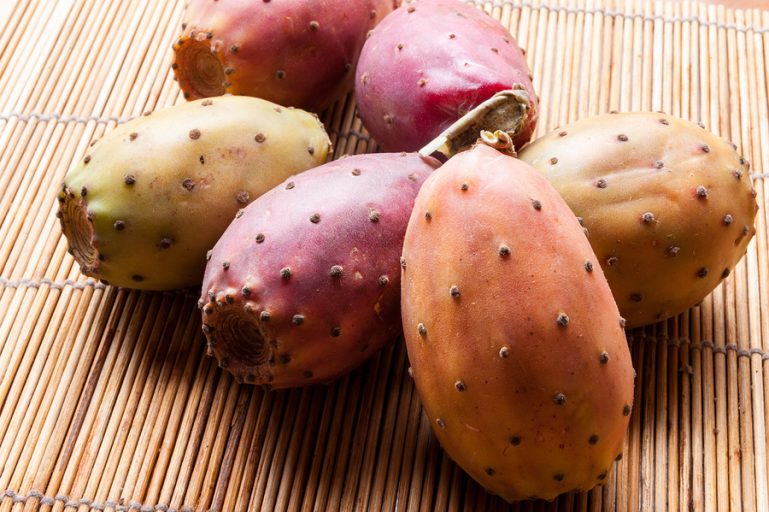The Sonoran Desert may appear to be barren to the unacquainted eye, but surprisingly it has around 540 edible plants. Native Arizonan cultures have been harvesting these plants for food and nourishment for hundreds of years. It truly is an edible desert.

The safest way to learn to identify and experience eating desert plants is with a trained guide. The Boyce Thompson Arboretum and several of the local Jeep and Hummer tours have guides that are very knowledgeable in the edible plants of the Sonoran Desert.
Here is a list of just some of the native desert plants that are safe for you to eat.
- Jumping Cholla The jumping cholla is a tree-like plant with a low-branching trunk that has limp branches of chained fruit. It is covered in tiny spines that attach very easily to a person. The cholla buds and fruit are edible, however this is a cactus that will really make you work for the food.
The fruit of the jumping cholla is edible year round, the larger fruits are better tasting. The inside is edible raw, or the whole thing if it is boiled first.
Cholla buds are in bloom in April and sometimes part of May. They are low in calories, but high in iron and calcium. They also contain complex carbohydrates.
- Saguaro Cactus Fruit The Tohono O’odham people once relied heavily on the ruby red fruit of the saguaro cactus. The fruits are 6–9 cm long and ripen in June. Each fruit contains around 2000 seeds and fleshy connective tissue (pulp).
The fruit has a sweet mild taste, almost like strawberries, and the small black seeds of the fruit give it a nutty flavor. It can be made into jam, syrup and even wine. The Tohono O’odham tribes celebrate the beginning of their summer growing season with a ceremony using a fermented drink made from the fruit to summon rains that are vital for their crops.
Saguaro cactus fruit contains vitamin C, vitamin B12, and dietary fiber. It is also has hydrating properties.
- Creosote Bush This is a brown bush that has green stems and darker green leaves with yellow flowers. The flowers look a little like daffodils. Chewing or sucking on the twigs will help to relieve thirst. Steeped leaves are used as a tea. When used as a tea, the leaves and small twigs must be gathered, washed, and dried in the sun.
- Agave There are four parts of the agave that are edible: the flowers, sap, leaves, and the stalks or basal rosette. It can be eaten in a variety of ways.
The stalks are ready in the summer, before the plant blossoms. Roasted stalks are rather sweet. Some farmers markets have roasted agave stalk for sale.
The agave leaves are harvested in the winter and spring when their sap content is the highest. They are cut into large chunks and baked or roasted. Roasted agave leaves have a rich caramel flavor but are highly fibrous, so the leaves are chewed and the left-over fibers are thrown out.
In order to harvest the sap an agave should be at least six to eight years old. The harvested sap, or agua miel (honey water), is sweet with a mild bitterness. The sap can be eaten fresh or it can be boiled down to make a syrup. Agave syrup (sometimes called agave nectar) is often used as an alternative to sugar in cooking. If the sap sits longer than a few hours it starts to ferment. Fermented sap can be made into vinegar or even pulque, an alcoholic beverage. (Tequila and mescal are two more popular alcoholic beverages that are made from the agave plant.)
The agave flowers in the summer. The flowers and the buds can both be eaten, but need to me steamed or boiled first. Once the flowers are boiled they can be added to scrambled eggs or soups, or even battered and fried and eaten on their own. Remove the pollen tips before cooking to avoid a bitter flavor. Agave flowers (flor de agave) can be found in Mexican produce markets and farmers markets as well.
- The prickly pear cactus is probably one of the better known edible desert plants. After you remove the thorns, the prickly pear cactus pads (or leaves) can be eaten raw or cooked. They make an excellent addition to your salad after you boil and chop them.
The fruit of the prickly pear is often found in Arizona gift shops being sold as jam or candies. The prickly pear fruit (called a Tuna) can be eaten both cooked and raw, and also makes an excellent juice. There is evidence that the juice of the fruit of prickly pears lowers blood cholesterol.
Raw prickly pear contains 17% of the daily recommended vitamin C for adults, and 24% of the daily recommended magnesium. They also contain potassium, folate, vitamin B6, and calcium amongst other nutrients.
Do not eat a prickly pear cactus with orange-crossed thorns or unripe fruits as they are poisonous. The fruits are ripe when they are bright red. In addition to eating, the pads can be used for treating sunburns. Just cut the pad and press the moist insides to the affected skin.
Who would have thought that a place that seems so harsh could provide such sustenance? Remember to always check and double-check the identity of the plant before eating it. You should be very cautious when eating plants found in the wild if you aren’t sure what you are doing.

